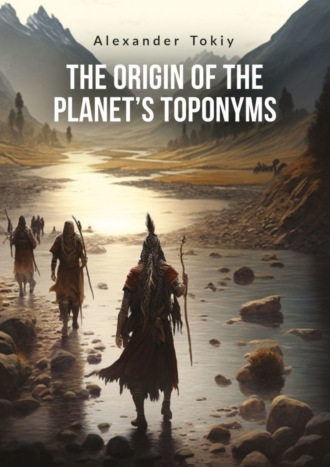
Полная версия
The Origin of the Planet’s Toponyms
Well, the preposition “dlya” is a combination of the words “do” and the soft “l”. “Do-lya” is the distance to something desired, loved or moving towards it. The Russian word “dolya” (fate) came out of this ancient notion.
16. The combination of protoroots (ancient prepositions) “do” and “no”: “dono”
Let us imagine that our ancient ancestors, traveling, came to a deep river. The leader wanted to wade through it, poked a stick into the water, but the stick did not rest anywhere. There is no stop, there is no limit. There is no “do” – deep down to it. He looked back at his fellow tribesmen, threw up his hands and said: Do no [dɔnɔ]. May be he spoked differently, but the combination of the protoroots (ancient prepositions) “do” and “no” formed a complex protoroot “dono”, which explains that there is no limit (dnois bottom). It is deep. Now the simplified word “dno” has the opposite meaning: a certain surface, a rest under water. However, this meaning became “dno” when deep rivers seemed to be an abyss bezdna (without a bottom). It is interesting to trace the way of protoroot from the understanding of “glubina” (depth) to the name Abadonna, personifying the diabolical power, the image of which Mikhail Bulgakov borrowed from ancient religions, for example, the Hebrew ǍḇaddōN – death, decomposition, annihilation, cessation of being. Probably, it seemed like hell for our ancestors when the waters of the Don River absorbed an unlucky tribesman and he could not get out of this abyss – dno. Understanding the “glubina” (depth) created not only the terrible word “ad” (hell) – “a-ba-ad-do-no”, but also popular now “Armageddon”, the meaning of which is the flooding of the earth – “ar” – with water: the same world flood that happened, happens and will happen in the future. Someday compatriots will learn to understand our great language and they will discover the innermost secrets lying on the surface.
17. Protoroots “kov”, “sak” and “skvo”
in the names of the locality
The root “kov” (gov) is quite common in geographical names. This is our Moskva (Moscow) (Moskov), and Koblenz, and Kovel, and Spanish Covadonga, and hundreds of others. What does the root “kov” mean? If we look into the English dictionary, we will see that the word “cow” has several homogeneous meanings. “Cov” is primarily a female. Moreover, a female elephant, and a female whale, and a female seal, and a female rhinoceros, and in general a female of all more or less large animals, and, of course, a female cow. What does this “cov” mean? Let us look at the protoroots: “ko” is both something round and some kind of movement. “V” is both “vnutri” (inside) and “zhizn’” (life). How did ancient hunters distinguish males from females? Well, first on the genitals. “Kov” is the name of the female’s sexual organ, literally: “circle giving life” or “circle of life”. The values could expand, change, but for our ancestors it was clear that the female, unlike the male, could reproduce offspring. The protoroot “kov” has been preserved not only in the English word “cow” – a female of a large animal, but also in the words: cavalier, podkova (horseshoe), govyadina (beef), in many other words and most accurately in the Ukrainian word “kovbasa” is a dish from the head of a female animal.
We have puzzled out the protoroot “Kov”. What is “sak”? It is clear that males do not have “kov”. In addition to phallic strength, they are distinguished from females by the scrotum, a pouch with seminal fluid. In the ancient language, the bag was called “sak”. In Latin – “sacculi”, in English – sac; in Greek, the word sounds a little different, but the root basis was preserved: askos – a bag, a scrotum. Hence is the word “sex”. This short word, however, has retained two protoroots: “sk” and “s”. The first means “a bag”, the second means “water”, and “liquid”. In other words, we are talking about the seminal fluid of male animals, and the word itself was originally used as a term in cattle breeding, denoting the male sex. Later, they began to call the process of mating animals, when bulls were brought to cows. Well, nowadays people have dragged this word on themselves. How could the word “sak” appear? “S” is water, and “ak” is from the protoroot “yag” or “ya-ga”, it is “the way down”, which received the meaning of “sacrifice”. Baba Yaga is the one who sacrificed to the swamp fires, the swamp. What could “water sacrifice” mean? Water could not flow out from this cavity. The “imprisonment” of water in some kind of stone bag that people could use as a vessel. Therefore, the word “sak” got the meaning of “bag”, which is still used today. For example, the word “sakvoyazh” is a bag for “voyage”, travelling bag.
Конец ознакомительного фрагмента.
Текст предоставлен ООО «Литрес».
Прочитайте эту книгу целиком, купив полную легальную версию на Литрес.
Безопасно оплатить книгу можно банковской картой Visa, MasterCard, Maestro, со счета мобильного телефона, с платежного терминала, в салоне МТС или Связной, через PayPal, WebMoney, Яндекс.Деньги, QIWI Кошелек, бонусными картами или другим удобным Вам способом.




